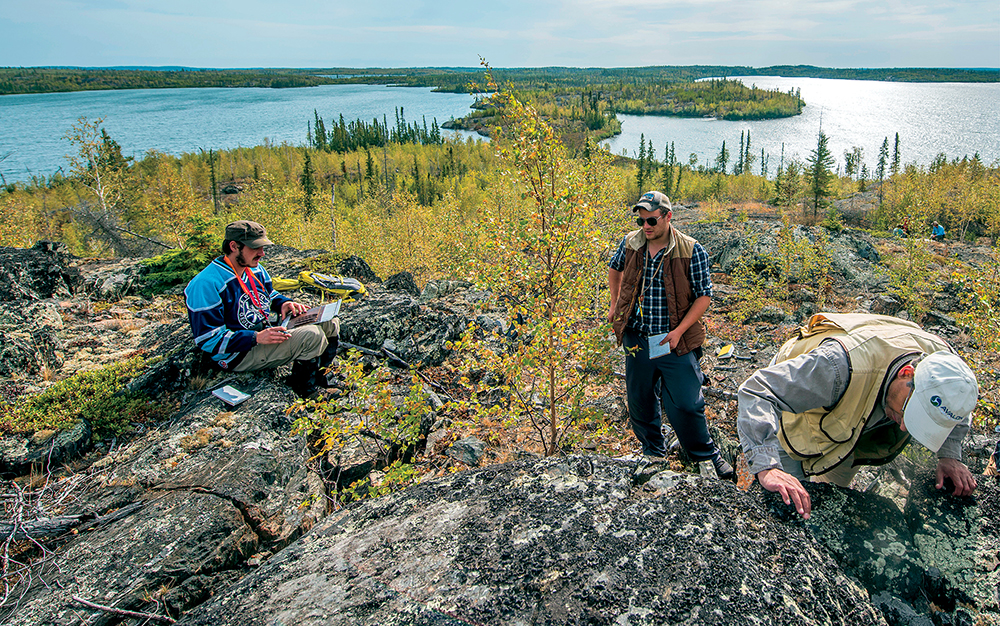
[Photo Credit: John Ulan]
One day this past summer, in the final days of Stéphane Poitras's last field school to complete his geology degree, he was walking alone along the shore of isolated Bell Lake in the Northwest Territories.
That's when he saw the rock. He'd never seen anything like it. It was a chance discovery that would shape the focus of his studies.
Field school had been more than a thrilling flight to the North and zipping around the lake in boats. It had allowed Poitras a real-world opportunity to apply geological theory outside the classroom in a remote part of the Canadian Shield, working with state-of-the-art equipment to map and measure bedrock distributions, record field descriptions and collect structural data. But even though he was gaining confidence and skills by being out in the field, he was struggling to find an honours thesis topic to complete his undergraduate degree.
Poitras called down the beach to his professor, Tom Chacko. The rock Poitras found turned out to be a rare volcanic ash layer from the Archean Eon that formed nearly three billion years ago when the Earth's crust was still young. Scientists have evidence of a volcanic eruption during the period, but as yet, no one has successfully dated it. Poitras's discovery of the rock could prove to be a key contribution to the field because, unlike other volcanic rocks, the ash layer can be used to determine the age of the eruption.
The earth sciences are practical sciences and, as Poitras's experience illustrates, ideas and understanding in the earth sciences most often start on the ground. Given the Canadian economy's heavy reliance on the sustainable development of natural resources, demand is high for geologists with excellent field skills. The Association of Professional Engineers and Geoscientists of Alberta recognizes this and requires its members to have participated in a minimum of one field school experience during their undergraduate degree. The University of Alberta has been running geology field schools for 50 years, part of a larger geoscience field school program that offers a variety of practical experiences. The opportunity Poitras had to map virgin geological territory alongside university and field geologists in the Northwest Territories is the only such student experience offered in Canada.
Most courses run for 10 days in early May, allowing students to participate before starting their summer jobs. Although Poitras and his classmates were flown to the Northwest Territories for their advanced-level field school, most field schools are in Jasper or Canmore, Alta., and the Interior of British Columbia. For these trips, everyone piles onto a bus in Edmonton and travels together to the field. Professors take the opportunity to get to know the students and talk to them about working safely on the mountain and in the field. Instruction includes how to defend against bears, cougars and mountain goats. Apart from these outdoor skills, field school camps nurture a sense of camaraderie among students and professors; everyone is housed together and meals are communal, complemented by starlit campfires and marshmallow roasts.
The fieldwork challenges students to apply the concepts learned during the school year. Teams of three and four will climb more than 100 metres to study a rock outcropping. From these outcroppings, students determine the geology of the rest of the area that is under cover, hidden by trees and grass. From the assessments, students draw maps of the underlying rocky structures of the hillside areas they've explored. In addition to nurturing a deeper understanding of the natural wonders of our planet, field schools also often inspire a love of fieldwork.
Philanthropic support helps to directly offset the cost to students, helping them afford this experience and get a jump on the skills they need for a career in the field.
Standing on the rocky outcropping of Bell Lake's silent shore that late-August day, both student and professor were inspired by the piece of ancient volcanic ash Poitras held in his hand. This was a chunk of Earth's history. Poitras had discovered more than a thesis topic and an opportunity to make a major contribution to the field; he had embarked on his professional path. "[Field school is] not only academic-life-changing," says Poitras, "it's character-building."